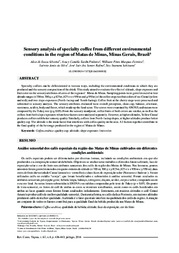Sensory analysis of specialty coffee from different environmental conditions in the region of Matas de Minas, Minas Gerais, Brazil.
Sensory analysis of specialty coffee from different environmental conditions in the region of Matas de Minas, Minas Gerais, Brazil.
Author(s): SILVEIRA, A. de S.; PINHEIRO, A. C. T.; FERREIRA, W. P. M.; SILVA, L. J. da; RUFINO, J. L. dos S.; SAKIYAMA, N. S.
Summary: Specialty coffees can be differentiated in various ways, including the environmental conditions in which they are produced and the sensory composition of the drink. This study aimed to evaluate the effect of altitude, slope exposure and fruit color on the sensory attributes of cafes of the region of Matas de Minas. Sampling points were georeferenced in four altitude ranges (< 700 m; 700 < x> 825 m, 825 < x < 950 m and > 950 m) of the coffee crop; two fruit colors of var. Catuaí (yellowand red); and two slope exposures (North-facing and South-facing). Coffee fruit at the cherry stage were processed andsubmitted to sensory analysis. The sensory attributes evaluated were overall perception, clean cup, balance, aftertaste, sweetness, acidity , body and flavor, which made up the final score. The scores were examined by ANOVA and means werecompared by the Tukey test (p < 0.05). From the sensory standpoint, coffee fruits of both colors are similar, as well as the cof fees from both slope exposures when these factors were analyzed separately . However , at higher altitudes, Y ellow Catuaí produces coffees with better sensory quality . Similarly , coffees from North-facing slopes, at higher altitudes produce better quality cup. The altitude is the main factor that interferes with coffee quality in the area. All factors together contribute tothe final quality of the beverage produced in the region of Matas de Minas.
Publication year: 2016
Types of publication: Journal article
Unit: Embrapa Coffee
Observation
Some of Embrapa's publications are published as ePub files. To read them, use or download one of the following free software options to your computer or mobile device. Android: Google Play Books; IOS: iBooks; Windows and Linux: Calibre.
Access other publications
Access the Agricultural Research Database (BDPA) to consult Embrapa's full library collection and records.
Visit Embrapa Bookstore to purchase books and other publications sold by Embrapa.

